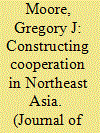|
|
|
Sort Order |
|
|
|
Items / Page
|
|
|
|
|
|
|
| Srl | Item |
| 1 |
ID:
123705


|
|
|
|
|
| Publication |
2013.
|
| Summary/Abstract |
What are the obstacles to greater cooperation in Northeast Asia and why have the nations of the region not been entirely successful in moving beyond history, toward greater cooperation? Conducting a brief survey of Northeast Asian IR and power alignment patterns from the Imperial/Dynastic era to the present, this essay utilizes the constructivist approach to assess regional alignment patterns in Northeast Asian history corresponding to six historical time periods, ranging from Ming China to the present. It does so by employing Wendt's system-level cultures of anarchy (Hobbesian, Lockean and Kantian cultures) at the dyadic/second level of analysis and the regional level of analysis (level 2.5), rating the various eras as to levels of cooperation vs enmity, with an eye to identifying the reasons for today's tension points. It concludes that despite such tension points and unresolved historical issues, anarchy in Northeast Asia today is not Hobbesian (enmity), but rather Lockean (rivalry). Consequently and first, war, nuclear proliferation and security spirals may be avoidable with proper sensitivity to the issues that continue to pose as obstacles to regional cooperation, including historical grievances, uncertainties over China's rise and the US role in the region, the North Korean nuclear issue and others. Second, attention to improving the dyadic cultures (China-Japan, South Korea-North Korea, etc.) that together comprise the region's relational culture (either Hobbesian, Lockean or Kantian) make greater regional cooperation possible and even more likely.
|
|
|
|
|
|
|
|
|
|
|
|
|
|
|
|
| 2 |
ID:
180006


|
|
|
|
|
| Summary/Abstract |
In this essay, an attempt is made to use Alexander Wendt’s structural hypothesis to test
the structures of Vietnam–China relations from the beginning up to the present. The
results show that Vietnam–China relations have undergone three cultures: Hobbesian
culture, Lockean culture, and Kantian culture. In 113 B.C, without any restraint, the
expansionist identity of China formed Vietnam–China Hobbesian culture and then
nourished it up to the late twelfth century. Then, the external restraints changed
Vietnam–China Hobbesian culture into the Lockean culture in 1164. There was an
alternation of Hobbesian and Lockean culture in the period of 1164–1885. The
transitions of these two cultures were created by external restraint and self-restraint.
In the period of 1885–1949, the foundations for the Kantian culture was laid. From
1950 to July 1978, Communist ideology helped the Kantian culture to dominate
Vietnam–China relations. Though, from 1968 self-interests created a shift from Kantian
culture to Lockean culture. Without self-restraint, the identities of Vietnam and China
changed the Kantian culture into the Lockean culture in late 1978, and this culture has
been dominating Vietnam–China relations up to the present.
|
|
|
|
|
|
|
|
|
|
|
|
|
|
|
|
|
|
|
|
|